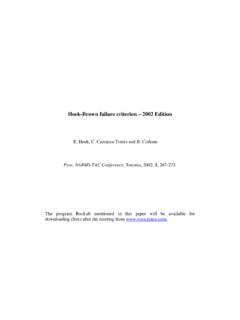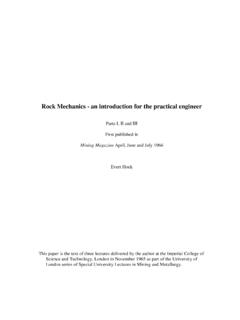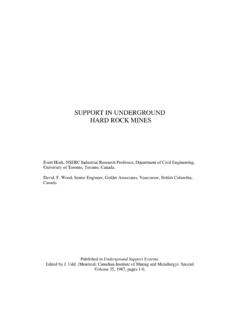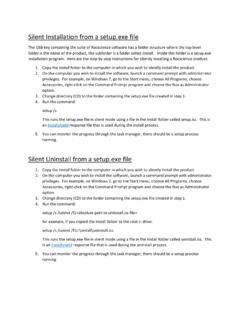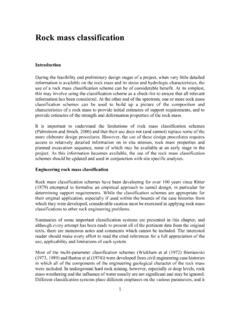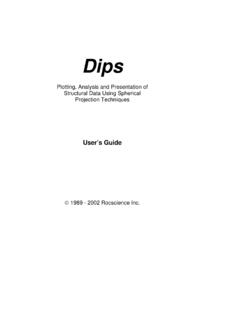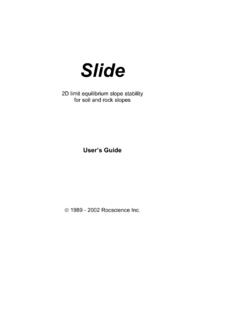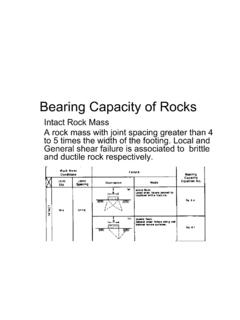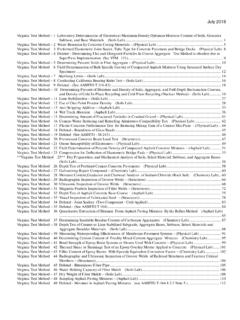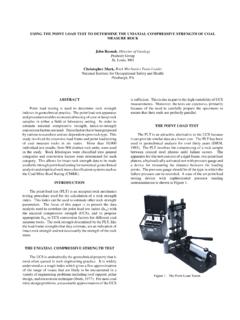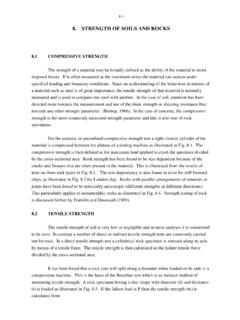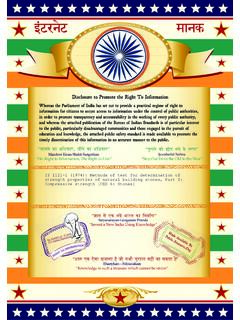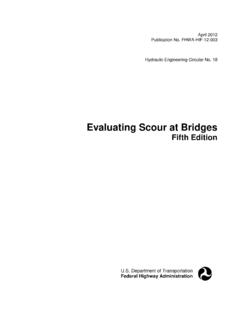Transcription of Rock mass properties - Rocscience Inc.
1 Rock mass properties Introduction Reliable estimates of the strength and deformation characteristics of rock masses are required for almost any form of analysis used for the design of slopes, foundations and underground excavations. Hoek and Brown (1980a, 1980b) proposed a method for obtaining estimates of the strength of jointed rock masses, based upon an assessment of the interlocking of rock blocks and the condition of the surfaces between these blocks. This method was modified over the years in order to meet the needs of users who were applying it to problems that were not considered when the original criterion was developed (Hoek 1983, Hoek and Brown 1988). The application of the method to very poor quality rock masses required further changes (Hoek, Wood and Shah 1992) and, eventually, the development of a new classification called the Geological strength Index (Hoek, Kaiser and Bawden 1995, Hoek 1994, Hoek and Brown 1997, Hoek, Marinos and Benissi, 1998, Marinos and Hoek, 2001).
2 A major revision was carried out in 2002 in order to smooth out the curves, necessary for the application of the criterion in numerical models, and to update the methods for estimating Mohr Coulomb parameters (Hoek, Carranza-Torres and Corkum, 2002). A related modification for estimating the deformation modulus of rock masses was made by Hoek and Diederichs (2006). This chapter presents the most recent version of the Hoek-Brown criterion in a form that has been found practical in the field and that appears to provide the most reliable set of results for use as input for methods of analysis in current use in rock engineering. Generalised Hoek-Brown criterion The Generalised Hoek-Brown failure criterion for jointed rock masses is defined by: a 3'. 1' 3' ci mb s (1). ci where 1' and wheresigma sub1 3' ' and sigma are the sub3 ' are maximum andthe maximum minimum and minimum effective effective principal principal stresses stresses at failure, at failure, mb is the value of the Hoek-Brown constant m for the rock mass , s and a are mb is the value of the Hoek-Brown constant m for the rock mass , constants which depend upon the rock mass characteristics, sigma sub ci is the uniaxial compressive strength sofand are constants the aintact which depend upon the rock mass characteristics, and rock pieces.
3 Ci is the uniaxial compressive strength of the intact rock pieces. Rock mass properties Normal and shear stresses are related to principal stresses by the equations published by Balmer1 (1952). 1' 3' 1' 3' d 1' d 3' 1. n' (2). 2 2 d 1' d 3' 1. d 1' d 3'. 1' 3' (3). d 1' d 3' 1. where d 1' d 3' 1 amb mb 3' ci s a 1. (4). In order to use the Hoek-Brown criterion for estimating the strength and deformability of jointed rock masses, three properties ' of the rock mass have to be estimated. These are: uniaxial compressive strength ci of the intact rock pieces, value of the Hoek-Brown constant mi for these intact rock pieces, and value of the Geological strength Index GSI for the rock mass . Intact rock properties For the intact rock pieces that make up the rock mass , equation (1) simplifies to: 3'. 1' 3' ci mi 1 (5). ci The relationship between the principal stresses at failure for a given rock is defined by two constants, the uniaxial compressive strength ci and a constant mi.
4 Wherever possible the values of these constants should be determined by statistical analysis of the results of a set of triaxial tests on carefully prepared core samples. Note that the range of minor principal stress ( 3' ) values over which these tests are carried out is critical in determining reliable values for the two constants. In deriving the original values of ci and mi , Hoek and Brown (1980a) used a range of 0 < 3' < ci and, in order to be consistent, it is essential that the same range be used in any laboratory triaxial tests on intact rock specimens. At least five well spaced data points should be included in the analysis. 1. The original equations derived by Balmer contained errors that have been corrected in equations 2 and 3. 2. Rock mass properties One type of triaxial cell that can be used for these tests is illustrated in Figure 1.
5 This cell, described by Franklin and Hoek (1970), does not require draining between tests and is convenient for the rapid testing on a large number of specimens. More sophisticated cells are available for research purposes but the results obtained from the cell illustrated in Figure 1 are adequate for the rock strength estimates required for estimating ci and mi . This cell has the additional advantage that it can be used in the field when testing materials such as coals or mudstones that are extremely difficult to preserve during transportation and normal specimen preparation for laboratory testing. Figure 1: Cut-away view of a triaxial cell for testing rock specimens. 3. Rock mass properties Laboratory tests should be carried out at moisture contents as close as possible to those which occur in the field. Many rocks show a significant strength decrease with increasing moisture content and tests on samples, which have been left to dry in a core shed for several months, can give a misleading impression of the intact rock strength .
6 Once the five or more triaxial test results have been obtained, they can be analysed to determine the uniaxial compressive strength ci and the Hoek-Brown constant mi as described by Hoek and Brown (1980a). In this analysis, equation (5) is re-written in the form: y m ci x s ci (6). where x 3' and y ( 1' 3' ) 2. For n specimens the uniaxial compressive strength ci , the constant and mi the coefficient of determination r 2 are calculated from: y xy ( x y n) x ci2 (7). n 2 2 n x (( x ) n). 1 xy ( x y n). mi (8). ci 2 2. x (( x ) n). 2. xy ( x y n r2 (9). [ x2 ( x) 2 n][ y2 ( y ) 2 n]. A spreadsheet for the analysis of triaxial test data is given in Table 1. Note that high quality triaxial test data will usually give a coefficient of determination r 2 of greater than These calculations, together with many more related to the Hoek-Brown criterion can also be performed by the program RocLab that can be downloaded (free) from When laboratory tests are not possible, Table 2 and Table 3 can be used to obtain estimates of ci and mi.)
7 4. Rock mass properties Table 1: Spreadsheet for the calculation of ci and mi from triaxial test data Triaxial Triaxialtesttest datadata x x sig3 sig1 y y xy xy xsq xsq ysq ysq sig3 sig1. 0 0 2151766. 2151766. 5 5 20636668. 20636668. 28398241. 28398241. 15 15 102421687. 102421687. 20 20 170680899. 170680899. 324289261. 324289261. sumx sumx sumysumy sumxy sumxsq sumxy sumxsq sumysq sumysq Calculation Calculation resultsresults Number of tests n= 5. Uniaxial strength sigci = Hoek-Brown constant mi = Hoek-Brown constant s= Coefficient of determination r2 = Cell Cell formulae formulae y = (sig1-sig3)^2. y = (sig1-sig3)^2. sigci sigci = SQRT(sumy/n = SQRT(sumy/n - (sumxy-sumx*sumy/n)/(sumxsq-(sumx^2)/n)* sumx/n). - (sumxy-sumx*sumy/n)/(sumxsq-(sumx^2)/n)* sumx/n). mi mi = = (1/sigci)*((sumxy-sumx*sumy/n)/(sumxsq-( sumx^2)/n)). (1/sigci)*((sumxy-sumx*sumy/n)/(sumxsq-( sumx^2)/n)).
8 R2r2 = ((sumxy-(sumx*sumy/n))^2)/((sumxsq-(sumx ^2)/n)*(sumysq-(sumy^2)/n)). = ((sumxy-(sumx*sumy/n))^2)/((sumxsq-(sumx ^2)/n)*(sumysq-(sumy^2)/n)). Note: These calculations, together with many other calculations related to the Hoek-Brown criterion, can also be carried out using the program Note: These calculations, together with many other calculations related to the Hoek-Brown RocLab that can be downloaded (free) from criterion, can also be carried out using the program RocLab that can be downloaded (free). from 5. Rock mass properties Table 2: Field estimates of uniaxial compressive strength . Uniaxial Point Comp. Load Field estimate of Grade* Term strength Index strength Examples (MPa) (MPa). R6 Extremely > 250 >10 Specimen can only be Fresh basalt, chert, Strong chipped with a diabase, gneiss, granite, geological hammer quartzite R5 Very 100 - 250 4 - 10 Specimen requires many Amphibolite, sandstone, strong blows of a geological basalt, gabbro, gneiss, hammer to fracture it granodiorite, limestone, marble, rhyolite, tuff R4 Strong 50 - 100 2-4 Specimen requires more Limestone, marble, than one blow of a phyllite, sandstone, schist, geological hammer to shale fracture it R3 Medium 25 - 50 1-2 Cannot be scraped or Claystone, coal, concrete, strong peeled with a pocket schist, shale, siltstone knife, specimen can be fractured with a single blow from a geological hammer R2 Weak 5 - 25 ** Can be peeled with a Chalk, rocksalt, potash pocket knife with difficulty.
9 Shallow indentation made by firm blow with point of a geological hammer R1 Very 1-5 ** Crumbles under firm Highly weathered or weak blows with point of a altered rock geological hammer, can be peeled by a pocket knife R0 Extremely - 1 ** Indented by thumbnail Stiff fault gouge weak * Grade according to Brown (1981). ** Point load tests on rocks with a uniaxial compressive strength below 25 MPa are likely to yield highly ambiguous results. Table 3: Values of the constant mi for intact rock, by rock group. Note that values in parenthesis are estimates. 6. Rock mass properties Rock type Class Group Texture Coarse Medium Fine Very fine ANV INANICHS. Clastic Sandstones. 17 not Conglomerates* (21 not Claystones 4 not Siltstones 7not equal equal to 3) Breccias equal to 4 to 2 Greywackes equal to 2 Shales 19 not equal (18 (6 not equal to 3) not equal to to 2) Marls 3) (7 not equal Non- Clastic Carbonates Crystalline Limestone Sparitic Limestones to 2).
10 Dolomites Micritic Limestones (9 not (12 not equal (10 not (9 not equal to 3). to 3) equal to 2) equal to 2). Evaporites Gypsum 8 not equal Anhydrite 12 not to 2 equal to 2. Organic Chalk 7 not equal to 2. Non Foliated Marble 9 not equal Hornfels (19 not Quartzites 20 not to 3 equal to 3. equal to 4) Metasandstone (19. not equal to Slightly foliated Migmatite (29 not Amphibolites 26. 3). equal to 3) not equal to 6. Foliated** Gneiss 18 not equal toSchists 12 not equal Phyllites (7 not Slates 5 to 3 equal to 3). SNOUNDI. Plutonic Light Granite 32 not equal to 3 Diorite 25 not equal to 5 Granodiorite (29 not equal to 3). Gabbro 27 not equal toDolerite (16 not equal 3 Norite 20 not equal to 5). to 5. Hypabyssal Porphyries (20 not equal Diabase (15 not Peridotite (25 not to 5) equal to 5) equal to 5). Volcanic Lava Rhyolite (25 not equal Obsidian (19 not Dacite (25 not equal to 5) Andesite to 3) Basalt equal to 3).
